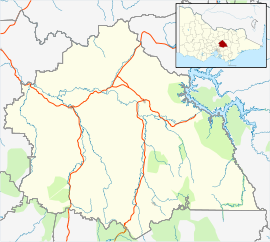Toolangi, Victoria
|
Toolangi Victoria |
|||||||||||||
|---|---|---|---|---|---|---|---|---|---|---|---|---|---|
| Coordinates | 37°32′S 145°28′E / 37.533°S 145.467°ECoordinates: 37°32′S 145°28′E / 37.533°S 145.467°E | ||||||||||||
| Population | 289 (2011 census) | ||||||||||||
| Postcode(s) | 3777 | ||||||||||||
| Location |
|
||||||||||||
| LGA(s) | Shire of Murrindindi | ||||||||||||
| State electorate(s) | Eildon | ||||||||||||
| Federal Division(s) | Indi | ||||||||||||
|
|||||||||||||
|
|||||||||||||
Toolangi is a rural township in Victoria, Australia. At the 2011 census, Toolangi and the surrounding area had a population of 289. It is situated on the edge of the Toolangi State Forest.
The name Toolangi is an Aboriginal word meaning tall trees. It is believed the area was known as Mt Rose up until the 1890s. Toolangi was first inhabited in the 1860s by paling splitters and then timber cutters, who camped deep in the bush. They were attracted by the huge stands of mountain ash (Eucalyptus regnans), a tree that splits easily, and the messmate timber, which proved durable as a building material.
Toolangi Post Office opened on 1 August 1900 and closed in 1974.
It was not until the early 1960s that electricity came to Toolangi. Together with the opening of the Melba Highway, this created the impetus for industrial expansion in the area. An early development was the Potato Research Station (1945), which was followed by the Strawberry Certification Scheme.
On 7 February 2009, the Black Saturday bushfires reached Toolangi and led to two deaths and 18 homes burnt. Fire surrounded the town for weeks and the whole area was quarantined for three weeks. The township itself and a small segment of forest in the Toolangi State Forest to the east of the town survived.
A strangely-shaped wooden building surrounded by tall eucalypts is visible when driving through the town. This is the former Toolangi Forest Discovery Centre. This building was used for forest education, and thousands of primary, secondary and tertiary students visited every year. The Discovery Centre and education programs was run by the Department of Sustainability and Environment (DSE), however it was closed on 30 June 2012 due to difficulty in compliance with building requirements in bushfire-prone areas. With endorsement from DSE, long time environmental education specialists Gould League now conduct the same forest education programs, with previous DSE staff, simply without the use of the building.
There are several local walking tracks, which are detailed in information available at the centre, including the Wirra Willa Rain forest walk through local rainforest, the Yea River Walk opposite the centre, and the Forest Sculpture Trail, which takes in nine works by sculptors of international repute and views both of Melbourne and the district. Mount St Leonard is 5 km. to the south-east.
...
Wikipedia

